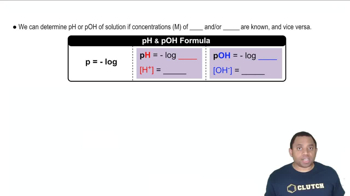Here are the essential concepts you must grasp in order to answer the question correctly.
pH and pOH
pH is a measure of the acidity or basicity of a solution, defined as the negative logarithm of the hydrogen ion concentration (pH = -log[H+]). A pH less than 7 indicates an acidic solution, while a pH greater than 7 indicates a basic solution. Understanding pH is crucial for determining the nature of the solution formed by mixing different substances.
Recommended video:
Buffer Solutions
A buffer solution is a system that resists changes in pH upon the addition of small amounts of acid or base. In this case, the combination of Na2HPO4 (a weak base) and H3PO4 (a weak acid) can create a buffer system. The Henderson-Hasselbalch equation can be used to calculate the pH of such a buffer solution, which is essential for understanding the final pH of the mixed solution.
Recommended video:
Stoichiometry of Acid-Base Reactions
Stoichiometry involves the calculation of reactants and products in chemical reactions. In this scenario, the amounts of NaOH, Na2HPO4, and H3PO4 must be considered to determine how they interact in solution. The neutralization reaction between the strong base (NaOH) and the weak acid (H3PO4) will affect the overall pH, making it important to analyze the stoichiometric relationships between these components.
Recommended video:




